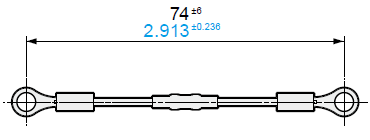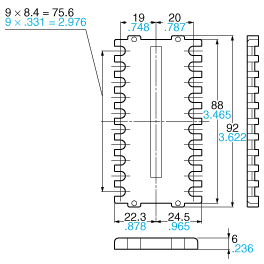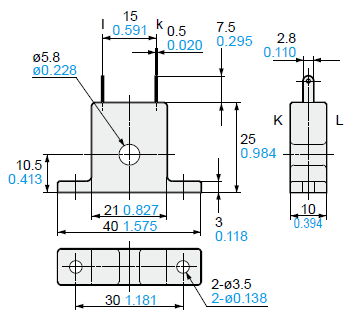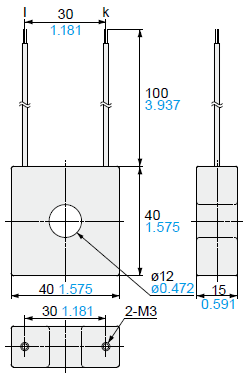KT9 Temperature Controllers (Discontinued Products)
Download
-
Discontinued Products
-
Rating/ Performance
-
Dimensions
-
Wiring/ Connection
-
Cautions For Use
Ⅾiscontinued
Last time buy (JST)
September 30, 2016
We are sorry, the products have been discontinued. Please refer to the details of the discontinued products and the recommended substitutes list below.
Discontinued Products

Rating/ Performance
Rating And Specifications
| Display | Specifications | |||
|---|---|---|---|---|
| KT9 | ||||
| Size | 96×96mm | |||
| Rating | Supply voltage (Must be specified) | 100 to 240V AC | ||
| 24V AC/DC | ||||
| Frequency | 50/60Hz | |||
| Power consumption | Approx. 8VA | |||
| Rated scale | Input type | Input range | ||
| Thermocouple | K | -200 to 1370°C(-320 to 2500 ℉) | ||
| -199.9 to 400.0°C(-199.9 to 750.0 ℉) | ||||
| J | -200 to 1000°C(-320 to 1800 ℉) | |||
| R | 0 to 1760°C(0 to 3200 ℉) | |||
| S | 0 to 1760°C(0 to 3200 ℉) | |||
| B | 0 to 1820°C(0 to 3300 ℉) | |||
| E | -200 to 800°C(-320 to 1500 ℉) | |||
| T | -199.9 to 400.0°C(-199.9 to 750.0 ℉) | |||
| N | -200 to 1300°C(-320 to 2300 ℉) | |||
| PL-II | 0 to 1390°C(0 to 2500 ℉) | |||
| C(W/Re5-26) | 0 to 2315°C(0 to 4200 ℉) | |||
| RTD | Pt100 | -200 to 850°C(-300 to 1500 ℉) | ||
| -199.9 to 850.0°C(199.9 to 999.9 ℉) | ||||
| JPt100 | -200 to 500°C(-300 to 900 ℉) | |||
| -199.9 to 500.0°C(-199.9 to 900.0 ℉) | ||||
| DC Current | 4 to 20mA DC | -1999 to 9999, -199.9 to 999.9 -19.99 to 99.99, -1.999 to 9.999 | ||
| 0 to 20mA DC | ||||
| DC Voltage | 0 to 1V DC | |||
| 0 to 10V DC | ||||
| 1 to 5V DC | ||||
| 0 to 5V DC | ||||
| · Scaling and change to the decimal point position is possible for DC current and DC voltage input. · DC current input is supported with an externally mounted 50Ω shunt resistor (sold separately). | ||||
| Multi-input | Thermocouple | K, J, R, S, B, E, T, N, PL-II, C (W/Re5-26) External resistor: Max. 100Ω (max. 40Ω external resistor for B input) | ||
| RTD | PT100, JPt100 3-conductor system (Allowable input conductor resistance for each conductor: max. 10Ω) | |||
| DC current | 0 to 20 mA DC, 4 to 20 mA DC Input impedance: 50Ω (Connect 50Ω shunt resistor between input terminals.) Allowable input current: max. 50 mA (when 50Ω shunt resistor is used) | |||
| DC voltage | · 0 to 1V DC Input impedance: min. 1 MΩ, Allowable input voltage: max 5 V, Allowable signal source resistance: max. 2 kΩ · 0 to 5 V DC, 1 to 5 V DC, 0 to 10 V DC Input impedance: min. 100 kΩ, Allowable input voltage: max 15 V, Allowable signal source resistance: max. 100Ω | |||
| Control output (Must be specified) | Relay contact(contact material:sliver alloy) | 1a1b | ||
| 1a 3A 250V AC (Resistive load),1a 1A 250V AC (Inductive load cosØ=0.4), Electric life: 100,000 times | ||||
| Non-contact DC voltage | 12+20 V DC, Max. load current: 40mA (Short-circuit protected) | |||
| DC current | 4 to 20mADC Load resistance: Max. 550Ω | |||
| Alarm output 1 | Relay contact 1a 3A 250VAC (Resistive load) Electric life: 100,000 times | |||
| Alarm output 2 | The same as the one of Alarm output 1 | |||
| Control mode | Actions mentioned below can be selected by key operation. [Default PID] PID (with auto-tuning function), PI, PD (with manual reset function), P (with manual reset function), ON/OFF action | |||
| Target temperature setting | Primary setting/secondary setting (switched by external terminal) | |||
| Program control function | - | |||
| Accuracy | Thermocouple | Within ±0.2% ±1 digit of each input span or within ±2°C (4℉) whichever is greater However, R and S input; Within ±6°C (12℉) in the range of 0 to 200°C (0 to 400℉) B input 0 to 300°C (0 to 600℉): Accuracy is not guaranteed. K, J, E, and N input less than 0°C (32℉): Within ±0.4% ±1 digit of input span | ||
| RTD | Within ±0.1% ±1 digit of each input span or ±1°C (2℉) whichever is greater | |||
| DC current and DC voltage | Within ±0.2% ±1 digit of each input span | |||
| Sampling period | 250ms | |||
| Hysteresis | Thermocouple and RTD: 0.1 to 100.0°C (℉) DC current and DC voltage: 1 to 1000 (The decimal point place follows the selection) | |||
| Proportional band | Thermocouple: 0 to 1000℃ (0 to 2000 ℉) RTD: 0.0 to 999.9℃ (0.0 to 999.9 ℉) DC current and DC voltage: 0.0 to 100.0% | |||
| Integral time | 0 to 1000 seconds | |||
| Derivative time | 0 to 300 seconds | |||
| Proportional cycle | 1 to 120 seconds | |||
| Allowable voltage fluctuation | When 100 to 240V AC; 85 to 264V AC When 24V AC/DC; 20 to 28V AC/DC | |||
| Insulated resistance | 500V DC 10MΩ or greater | |||
| Breakdown voltage | 1.5kV AC for 1min between input terminal and ground terminal, between input terminal and power terminal between power terminal and ground terminal between output terminal and ground terminal, and between output terminal and power terminal | |||
| Malfunction vibration | 10 to 55 Hz (1 cycle/min.), single amplitude: 0.35 mm 0.014 in (10 min. on 3 axes) | |||
| Breakdown vibration | 10 to 55 Hz (1 cycle/min.), single amplitude: 0.75 mm 0.030 in (1 hour on 3 axes) | |||
| Malfunction shock | X, Y and Z each direction for 5 times 10G | |||
| Breakdown shock | Same as above, but 30G | |||
| Ambient temperature | 0 to 50°C | |||
| Ambient humidity | 35 to 85%RH (No condensation) | |||
| Mass | Approx. 370g | |||
| Waterproof | None | |||
| Display character height | PV:18mm SV:13.2mm | |||
| Options | Heating/Cooling control (Relay contact material:silver alloy) | Relay contact: 1a 250V AC 3A (Resistive load), 250V AC 3A (Inductive load cosφ=0.4), Electric life: 100,000 times Non-contact voltage: 12 V DC Max. 40mA (Short-circuit protected) DC current: 4 to 20mA DC Load resistance:Max. 550Ω | ||
| Heater burn-out alarm output (Relay contact material:silver alloy) | Heater rated current must be selected from 5A, 10A, 20A and 50A. Setting accuracy: Within 5% of heater rated current Relay contact 1a 250V AC 3A (Resistive load), Electric life: 100,000 times | |||
| Communication function | RS-485/Modbus Protocol (Modbus is a communication protocol developed for PLCs by Modicon Inc.) Communication speed: 2400/4800/9600/19200bps | |||
| Accessories | Mounting frame | Included with unit | ||
| Terminal cover | Sold separatel | |||
Communication Function Overview
| Item | Specification |
|---|---|
| Communication method | Half-duplex |
| Communication speed | Select 2,400, 4,800, 9,600, or 19,200 bps using key operation. |
| Synchronization type | Asynchronous |
| Protocol | Modbus |
| Coding | ASCII |
| Error correcting | Parity check and check sum |
| Error detection | Parity check, check sum |
| Data structure | Start bit: 1 Data bit: 7 Parity: Even parity Stop bit: 1 |
| Interface | EIA RS-485 compliant |
| No. of nodes | 31 |
| Maximum cable length | 1,000 m 3,280.840 ft(cable resistance must be within 50Ω |
Dimensions
- Unit: mm in
KT9 Series
General tolerance :
±1.0
±0.39

Panel cutout

Note) The communications terminal is the screw terminal on the back of the unit.
Shunt Resistor
AKT4810
Shunt resistor

Terminal Cover
AKT8801 (for KT8)
AKT9801 (for KT9)

* 2pcs of terminal cover of AKT8801 can be used as an AKT9801 cover.
Current Transformer (CT)
CT1
Current transformer (CT) (for 5, 10, and 20A)

CT2
Current transformer (CT) (for 50 A)

Note:Current transformer CT1 or CT2 is included (only with KT7 and KT4H)
when heater burnout alarm function is added.
Wiring/ Connection
External Connection Diagram

POWER SUPPLY : Power supply
OUT1 : Control output 1 (heat output)
OUT2 : Control output 2 (cooling output)
RELAY : Relay contact output
V/A : DC voltage output/direct current output
A1 : Alarm 1 output
A2 : Alarm 2 output
HB : Heater cutoff alarm output
SV2 : Second main setup
CT : CT input
TC : Thermocouple
RTD : Resistance temperature detection
DC : Direct current or DC voltage
RS-485 : Serial communications
*That main setting No. 2 will not be possible on the KT8 and KT9 when the communications functions is added.
Communication Function Connection Diagram (PLC Connection Diagram)

Cautions For Use
1.Notice on site selection
This instrument is intended to be used in the following environment (IEC61010-1) Overvoltage category II,
Pollution degree 2 Mount the controller in a place with:
- 1.A minimum of dust, and an absence of corrosive gases
- 2.No flammable, explosive gases
- 3.Few mechanical vibrations or shocks
- 4. No exposure to direct sunlight, an ambient temperature of 0 to 50°C (32 to 122 ℉) that does not change rapidly
- 5.An ambient non-condensing humidity of 35 to 85%RH
- 6.No large capacity electromagnetic switches or cables through which large current is flowing
- 7.No water, oil or chemicals or where the vapors of these substances can come into direct contact with the controller
2.Notice on wiring
- 1.The terminal block of KT4, 8 and 9 series are designed to be wired from the left side.
The lead wire must be inserted from the left side of the terminal, and fastened by the terminal screw.
Use a solderless terminal with insulation sleeve that fits to the M3 screw.

- 2.Terminal fastening torque is approximately 0.6N·m to 1.0N·m (KT4, 8 and 9).
For KT7 series by M2.6 screw is less than 0.5N·m and by M2.0 screw 0.25N·m respectively. - 3.Use a thermocouple and compensating lead wire according to the input specification of the controller.
- 4.Use a 3-wire system of RTD according to the input specification of the controller.
- 5.This controller has no built-in power switch, circuit breaker or fuse. Therefore, it is necessary to install them in the circuit near the external controller.
(Recommended fuse: Time-lag fuse, rated voltage 250V AC, rated current 2A) - 6.In the case of 24V AC/DC power supply, do not confuse the polarity when it is DC.
- 7.With the relay contact output type, use an auxiliary electromagnetic switch externally according to the capacity of the load to protect the built-in relay contact.
- 8.When wiring, keep input wire (thermocouple, RTD, etc.) away from AC source and load wire to avoid external interference.
- 9.Turn the power supply to the instrument off before wiring or checking. Working or touching the terminal with the power switched on may result in Electric Shock which could cause severe injury or death.
- 10.Do not drop wire chips into the holes of vent when wiring, because they could cause fire, malfunction or trouble with the device.
- 11.To prevent the unit from harmful effects of unexpected high level noise, it is recommended that a surge absorber be installed between the electromagnetic switch coils.
3.Notice on the mounting
- 1.Do not use excessive force while screwing in the mounting bracket of KT4, 8 and 9 series. Recommended torque is approximately 0.12N·m.
- 2.When mounting the KT7 series to the DIN rail, mount it in a lateral direction. Make sure a click is audible when fixed into place.
4.Optional heater burn-out alarm output
- 1.This alarm is not available for detecting current under phase control.
- 2.Use the current transformer (CT) provided, and pass one lead wire of the heater circuit into the hole of CT.
- 3.When wiring, keep CT wire away from AC source and load wire to avoid external interference.
